Characteristics of Paddlefish in a Southwestern U.S. Reservoir, with Comparisons of Lentic and Lotic Populations
Present address: Department of Wildlife and Fisheries Sciences, Post Office Box 2140B, South Dakota State University, Brookings, South Dakota 57007-1696, USA
Abstract
We evaluated the population characteristics of a self-sustaining population of paddlefish Polyodon spathula on the southwestern edge of its range to determine how its mortality, condition, and growth compare with those of other lentic populations and how they may differ from those of lotic populations. Paddlefish density estimates in Keystone Reservoir, Oklahoma, were similar to those in other southern self-sustaining reservoir populations. Paddlefish catch rates varied annually; higher catches occurred in the lower reservoir reaches and in the Arkansas River arm in 1997 and 1998 but in other locations in the reservoir in 1996. Annual mortality of 27–34% was primarily from natural causes. Condition (relative weight) was high, particularly for a population near the edge of its range. Annual growth increments based on back-calculation were not related to mean monthly air temperature or mean monthly minutes of daylight. The maximum age of paddlefish (14 years) was similar to that in other southern reservoirs. Growth rates were similar to those of other lentic populations and higher than that of lotic paddlefish collected in the Keystone Reservoir area before impoundment. Lentic populations, including that of Keystone Reservoir, had faster growth at age 0 than lotic populations, but growth rates were similar for ages 2–10, suggesting that initial growth differences produced the divergence between lentic and lotic populations. Although maximum age was not different between lentic and lotic populations, it was greater for northern waters, suggesting that latitudinal differences play a substantial role in paddlefish population characteristics. Lentic and lotic paddlefish populations may exhibit different life history characteristics (e.g., growth and mortality), but this lotic species has adapted well to reservoir environments, even near the southwestern edge of its range.
Introduction
Paddlefish Polyodon spathula inhabit large rivers and reservoirs throughout the central United States (Graham 1997). However, paddlefish have diminished in numbers during the last century because of destruction of spawning grounds, exploitation, dam construction, river channelization, dewatering of rivers, and pollution (Carlson and Bonislawsky 1981).
Paddlefish distribution, movement, and habitat use has been documented in rivers of the northcentral United States (Gengerke 1978; Rosen et al. 1982; Southall and Hubert et al. 1984; Moen et al. 1992). Although paddlefish have adapted and even thrived in impoundments, little is known about how these fish use reservoir environments (Russell 1986). In rivers, paddlefish concentrate near current breaks and eddies (Southall and Hubert et al. 1984; Moen et al. 1992; Zigler et al. 1999). In reservoirs, juvenile paddlefish prefer open water and avoid littoral areas (Pitman and Parks 1994). Adult paddlefish use of reservoir habitats may be influenced by river flows and possibly conductivity (Paukert and Fisher 2000). Because reservoirs generally are different than rivers (i.e., relative to water flow, depth, temperature, etc.), paddlefish habitat use and distribution in reservoirs may be influenced by different factors than for riverine populations.
Population characteristics have been documented for paddlefish in rivers and reservoirs, mostly in the southeastern United States (Pasch et al. 1980; Hageman et al. 1988; Hoffnagle and Timmons 1989; Reed et al. 1992; Hoxmeier and DeVries 1997). In rivers (Gengerke 1978; Hoxmeier and DeVries 1997) and reservoirs (Combs 1982; Hoffnagle and Timmons 1989; Reed et al. 1992; Scarnecchia et al. 1996), paddlefish growth is rapid during the first 2 years of life and decreases substantially thereafter. Paddlefish older than 15 years are common in many populations (Russell 1986), and the maximum reported age is 55 years (Scarnecchia et al. 1996).
Overexploitation is a primary factor contributing to the decline in paddlefish abundance (Carlson and Bonislawsky 1981). Concerns over recreational and commercial harvest of paddlefish began when Purkett (1963) reported that the Osage River, Missouri, population was overexploited at 24.5%. Combs (1982) concluded that exploitation greater 15% is excessive. However, estimates of angler exploitation rates often have been speculative (Hoffnagle and Timmons 1989; Reed et al. 1992; Boone and Timmons 1995). More accurate estimates of exploitation rates are needed to evaluate sport fisheries throughout the paddlefish's range.
We studied the population characteristics of paddlefish in Keystone Reservoir, Oklahoma, to determine how mortality, condition, and growth compare with other lentic populations and how these paddlefish may differ from lotic populations. Paddlefish were present in the Arkansas and Cimarron rivers before the Keystone Reservoir was impounded in 1964 (Linton 1961). Anecdotal reports indicate that the population has been increasing in size (Ambler 1994; Graham 1997). A springtime snag fishery for paddlefish has developed throughout the Keystone Reservoir system (Don Hicks, Oklahoma Department of Wildlife Conservation, personal communication). Apart from these reports, however, nothing is known about paddlefish in this system.
Although Keystone Reservoir apparently provides limited spawning habitat and potentially adverse environmental conditions (e.g., warm summer water temperatures, highly saline water, fluctuating water levels), the paddlefish population is self-sustaining (Graham 1997). The objectives of this study were to determine the distribution, abundance, age, growth, condition, and exploitation of this self-sustaining paddlefish population. We also compared the Keystone Reservoir population with other lotic and lentic populations and quantified differences in growth, mortality, and maximum age to better understand how paddlefish differ to these different habitat types.
Methods
Study site
The 10,600-ha Keystone Reservoir impounds the Arkansas and Cimarron rivers in northcentral Oklahoma just below their confluence (Figure 1). Large water-level fluctuations (e.g., >3 m during winter drawdowns) are common because of the large size of the drainage basin, its use for power generation, and flow regulation. During our winter sampling, little flow over Keystone Dam was noted. Conductivity is generally higher in the Cimarron River arm (i.e., ≤5,000 μS/cm; Paukert and Fisher 2000) than the Arkansas River arm of the reservoir (i.e., ≤1,200 μS/cm). The Cimarron River upstream of the Cimarron River arm is unimpounded and exhibits highly fluctuating flows. The Arkansas River, impounded by Kaw Dam 176 km above Keystone Dam, has regulated flows.
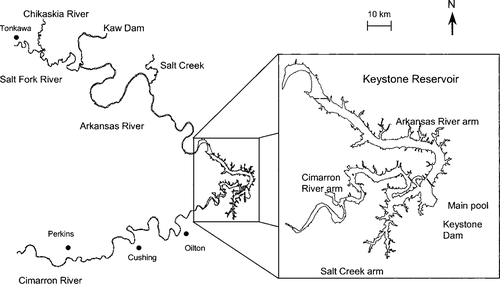
Keystone Reservoir and its major tributaries. The inset shows the four areas of the Keystone Reservoir: Cimarron River arm, Arkansas River arm, main pool, and Salt Creek arm
In the Keystone Reservoir system, the most popular sport fishery for paddlefish is in the tailwaters of Kaw Dam (Figure 1). Other sportfishing areas exist on the Cimarron and Salt Fork rivers but are limited by poor access and limited habitat (i.e., few deep pools).
Sampling procedures
We used a stratified random design to determine sampling sites in four areas of the reservoir: Arkansas River arm, Cimarron River arm, main pool, and Salt Creek arm (a large tributary of the Cimarron River arm; Figure 1). The reservoir was divided into 1.6-km-long reaches along the channels of the Arkansas River, Cimarron River, and Salt Creek arms. Reaches with maximum water depth less than 3.1 m were excluded as potential sites because paddlefish prefer deeper waters (Hubert et al. 1984; Zigler et al. 1999). Because the areas varied in size, sample sites (minimum of three) were proportionally allocated to each area. Paddlefish were collected with gill nets (91 m long by 4.5 m, 6.4 m, or 9.2 m deep) having one of three mesh sizes (127-mm, 152-mm, or 203-mm bar), which Paukert and Fisher (1999) reported collected all lengths of juvenile and adult paddlefish. We sampled during winter from January to March 1996 (23 nights), from November 1996 to February 1997 (27 nights), and from December 1997 to March 1998 (27 nights). Nets were usually fished overnight (16–22 h) and set perpendicular to the main river channel. Catch per unit effort (CPUE), was defined as number of fish collected per 108 m2 of gill net per 24-hr set time (Paukert and Fisher 1999).
Fish collected were measured (nearest millimeter) for eye-to-fork length (EFL; Ruelle and Hudson 1977), weighed (kilograms), tagged with an individually numbered jaw tag, and released near the capture site. To increase tag returns by anglers, we posted explanative signs at angling locations and bait shops, and provided notices to local newspapers. In addition, a baseball cap reward was given for each returned tag.
Dentary bones were removed from fish that died in the gill nets and, after cleaning and sectioning, were used to age the fish (methods of Reed et al. 1992). Back-calculated mean length at age was determined by measuring the distances from all annuli to the central lumen (Reed et al. 1992). The Weisberg linear growth model (Weisberg 1993) was used to evaluate the effects of the environment on paddlefish growth. This model partitions the variation in growth (i.e., dentary bone growth) into an age and year (environment) effect. Age effects are related to the size of the fish (i.e., as a fish ages, growth typically decreases); year effects (i.e., growth coefficient) are the interannual differences in growth due to the change in the environment (Weisberg 1993):

The growth coefficient is the measure of fish growth, which is based on the last sample year. If the growth coefficient is positive, growth was higher that year than the most recent year sampled, whereas a negative growth coefficient represents slower growth than the last year sampled.
Environmental effects measured were mean monthly air temperature, mean monthly deviation from normal air temperature, and mean number of minutes of sunlight per month (an indirect measure of potential productivity). All these values were recorded from 1984 to 1996 at the Tulsa International Airport, 33 km east of Keystone Reservoir.
Relative weight (Wr) was used to index condition:

At each gill-netting location, temperature, dissolved oxygen, and conductivity profiles were taken at 1-m intervals. Secchi disk transparency was also measured at each location. Discharge data for the Cimarron and Arkansas rivers were recorded at U.S. Geological Survey gauging stations in the Cimarron River (97 km upstream of Keystone Reservoir) and the Arkansas River (80 km upriver from Keystone Reservoir). Because gill nets were set overnight, we used discharge data recorded at midnight.
Lentic and lotic population comparisons
Using published and unpublished data, we compared characteristics of paddlefish populations from lentic (majority of life in reservoirs but may move up rivers in spring to spawn) versus lotic (reside exclusively in a riverine environment) waters. When this classification was questionable, we contacted the researcher who collected the data to clarify the habitat type occupied. Populations that inhabited characteristics of both lentic and lotic environments (e.g., pools on the Mississippi River, and run-of-the-river reservoirs) were excluded from the analyses. Population characteristics obtained from the literature were mean length at age, maximum age, and in some cases, total annual mortality. Von Bertalanffy growth functions (Ricker 1975) were used to estimate maximum attainable length (L∞) for each population.
Statistical analysis
Differences in catch rates among years and areas of Keystone Reservoir were tested with a two-way analysis of variance (ANOVA) with area and year as the main effects. Because a log-transformation did not stabilize the variance of CPUE, the data were ranked (Conover and Iman 1981). Linear regression was used to determine relationships between condition (Wr) and length, and an ANOVA was used to determine if mean Wr values across all lengths (assuming Wr did not differ among length in our regression analysis) differed among years. Total instantaneous mortality (Z) was estimated by the slope of the descending limb of the catch curve. Simple annual mortality was estimated as 1 − e−Z (Ricker 1975). For each month of the year, we regressed the Weisberg growth coefficient (an index of growth) against mean monthly air temperature, deviation for mean monthly air temperature, and total minutes of monthly sunlight to determine dependence of growth on these environmental variables for 1984–1996. Multiple regression was used to examine the dependence of CPUE on environmental variables (i.e., dissolved oxygen, conductivity, water temperature) measured at each fish sampling location. Collinearity diagnostics were used to detect multicollinearity.
We used analysis of covariance (ANCOVA) to compare the slopes and intercepts of the log10-transformed regression lines of mean length at age between lentic and lotic paddlefish populations. A two-way ANOVA was used to compare L∞ and maximum age (on ranked data, Conover and Iman 1981) between habitat type (lentic and lotic) and geographic area (north = North Dakota, South Dakota, Montana, and Idaho; mid = Kentucky, Tennessee, and Missouri; south = Oklahoma, Louisiana, Arkansas, and Alabama). All statistical analyses were preformed in SAS (SAS 1996) with α = 0.05.
Results
Keystone Reservoir Population Characteristics
We collected 1,412 paddlefish in Keystone Reservoir during the winters of 1996–1998. We tagged 1,138 with jaw tags. The remaining fish either died in our nets (161), were recaptures from previous tagging (67), were too small to tag (17), or were not tagged (29). Overall sampling mortality for the 3-year study was 11.4%; mortalities increased substantially when the water temperature was above 10°C. Therefore, we sampled when the water temperature was 10°C or less during the last 2 years of the study. Paddlefish density was estimated (using population estimates calculated for each of the 3 years; Paukert 1998) at 0.62, 0.84, and 0.97 fish/ha for 1996, 1997, and 1998, respectively.
Distribution of paddlefish, based on catch rates, varied among reservoir areas and years. Because there was an interaction between year and area (P = 0.01), we examined CPUE separately for each year and area of the reservoir. The Arkansas River arm CPUE was highest in 1997 and 1998 and lowest in 1996 (P = 0.04); Cimarron River arm CPUE was highest in 1996 and lowest in 1997 and 1998 (P < 0.0001). Main-pool CPUE increased over the 3-year period (P = 0.03). Catch rates in Salt Creek did not differ between 1997 and 1998 (P = 0.12), the 2 years this area was sampled. In 1996, paddlefish CPUE was highest in the Cimarron River arm compared with other areas (P < 0.0001). However, in 1997 our highest CPUE was in Salt Creek and our lowest was in the Cimarron River arm and main pool (P < 0.0001). There was no difference in CPUE among reservoir areas in 1998 (P = 0.16), and paddlefish CPUE peaked midway up the Arkansas River and Cimarron River arms. In general, CPUE exhibited a curvilinear relationship with distance above the dam, maximum abundance occurring 10–15 km upriver in both river arms. An exception to this trend occurred in 1996 in the Cimarron River arm, where maximum abundance was 20–25 km upriver from the dam.
Recaptures of jaw-tagged paddlefish also suggested that fish that were in the Cimarron River arm during winter 1996 were using other areas of the reservoir during winter 1997 and 1998. Of all recaptures at large at least 1 year, 62% were tagged in the Cimarron River arm in winter 1996 and recaptured in the Arkansas River or the Salt Creek arms in winters of 1997 and 1998. Paddlefish did not return to the Cimarron arm in winter 1997 or 1998 at levels as great as in 1996. Recaptures in 1998 and 1997 showed no trend in movement to or from any reservoir area.
Paddlefish CPUE increased with increasing surface (i.e., at a depth of 1 m) temperature and decreasing bottom (i.e., 1-m from the bottom) conductivity for all years and areas combined (R2 = 0.20, P = 0.01). In the Arkansas River arm, CPUE increased with decreasing surface dissolved oxygen (r2 = 0.23, P = 0.04), whereas CPUE increased with decreasing flow and bottom conductivity in the Cimarron River arm (R2 = 0.33, P = 0.02).
Dentary bones were removed from 106 paddlefish (309–1,323 mm EFL) for age analysis. Mean back-calculated length at age of paddlefish did not differ among years (P > 0.004, Bonferroni corrections), so all years were pooled. Ages of all other fish were assigned using the back-calculated mean length at age. The oldest aged paddlefish was 14 years old. Median age increased from age 3 in 1996 to age 4 in 1997 and to age 5 in 1998 (Figure 2). Instantaneous mortality for the fully recruited paddlefish population was higher in 1996 (Z = 0.414, r2 = 0.94) than in 1997 (Z = 0.315, r2 = 0.61) or 1998 (Z = 0.310, r2 = 0.83). Annual mortality rates were 33.9% in 1996, 27.0% in 1997, and 26.6% in 1998.
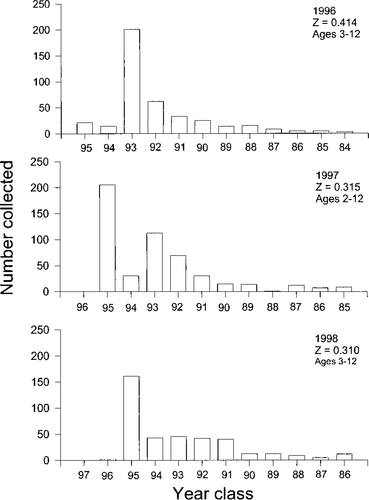
Age structure of paddlefish collected in Keystone Reservoir, Oklahoma, in 1996, 1997, and 1998
Paddlefish growth was fast in younger fish and decreased in older ages. Relative annual growth rate, or (EFLt+ 1 − EFLt) /EFLt, for age-1 fish was 57.4%, but decreased to less than 10% per year after age 4. Paddlefish growth (i.e., Weisberg growth coefficient) showed no interaction between age of fish at capture and year (P = 0.14) and did not differ among years (P = 0.11), suggesting that growth did not differ from year to year. Weisberg's growth coefficient was not significantly related to mean temperature, departure from mean temperature, or total minutes of sunlight for each month for each year from 1984 to 1996. This substantiated our findings of no among-year growth effects.
Paddlefish Wr was not related to length for all years combined (P = 0.41); therefore, we reported Wr for all fish sampled. Paddlefish relative weight was highest in 1996 (112) and lowest in 1997 (104) and 1998 (108; P < 0.001).
The public returned 29 tags during the 3-year study: 12 fish were intentionally snagged (5 from the Kaw Dam tailwaters, 3 in the Cimarron River, 1 in the Salt Fork River, and 3 below Keystone Dam), 9 were collected unintentionally by anglers (6 in Keystone Reservoir and 4 in the Keystone Dam tailwaters), 5 were found dead (3 in Keystone Reservoir and 2 below Keystone Dam), and 3 involved unresolved circumstances. All but one of the snagged fish were caught during the spring spawning migrations (February to May) and were typically large, mature fish (622–1,263 mm EFL). For each year, exploitation rates (number of tags returned by anglers/total number of tagged fish that year) varied from 0.5% in 1996 to 1.2% in 1997.
Lentic and Lotic Population Comparisons
We found data on mean length at age for 11 lentic and 5 lotic paddlefish populations (Table 1). Six other populations were removed from analysis (Pools 13, 19, and 20 on the Mississippi River, the Alabama River oxbows, Cahaba River, and Tallapoosa River) because these were considered intermediate between lentic and lotic environments.
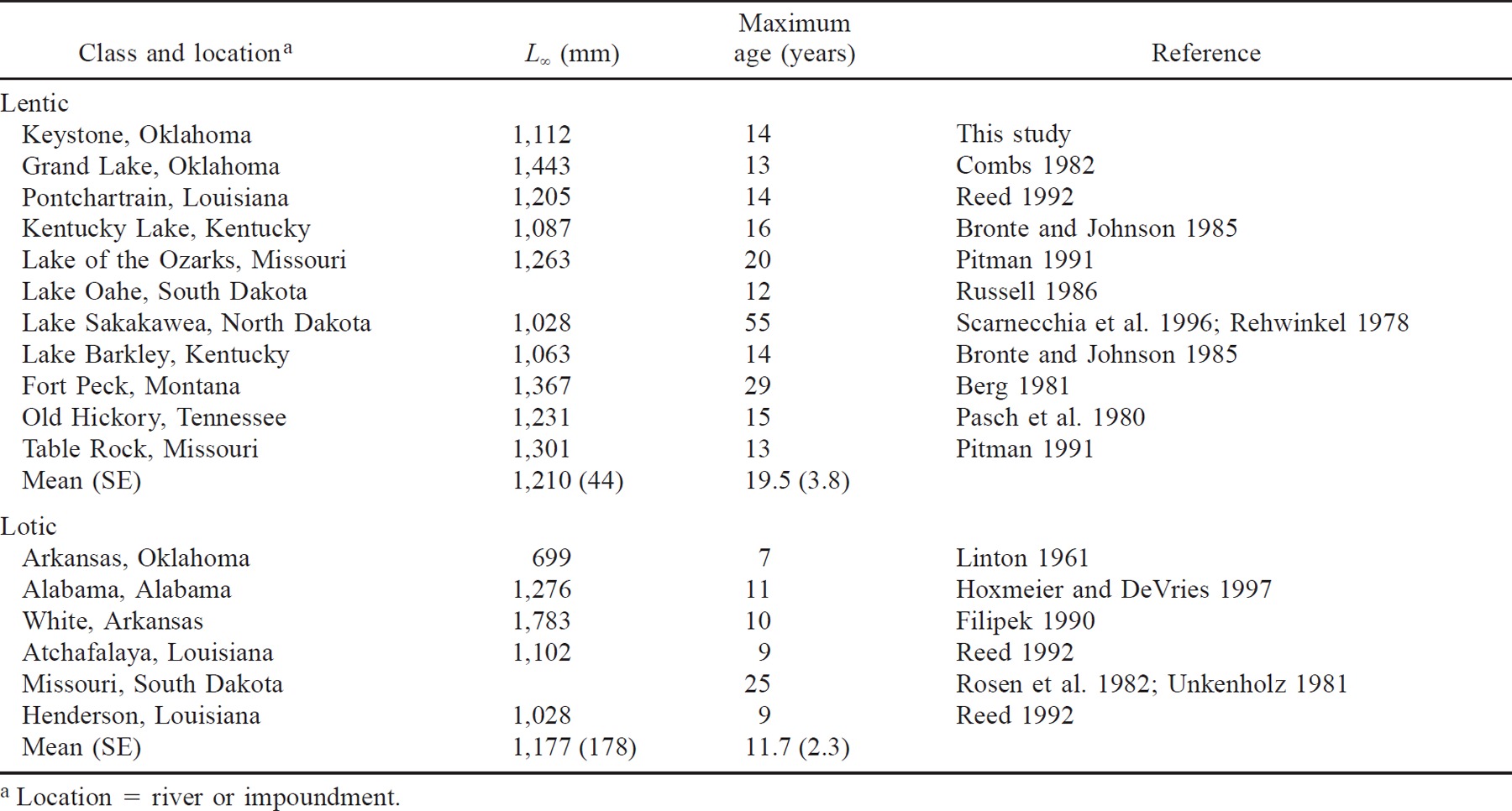
Maximum attainable length (L∞) did not differ between habitat types (P = 0.71) or among geographic regions (P = 0.95). The slope of the log-transformed length-at-age data did not differ between lentic and lotic paddlefish populations (P = 0.74), but the intercept was higher for lentic populations (P = 0.04)(Figure 3). Mean initial growth was higher for lentic populations (316 mm EFL) than lotic populations (283 mm EFL). A direct comparison between Keystone Reservoir and Arkansas River paddlefish before impoundment (Table 2) indicated the same trends, slopes of the log-transformed length-at-age lines not differing (P = 0.22); the Keystone Reservoir intercept, however, was higher (P < 0.001).
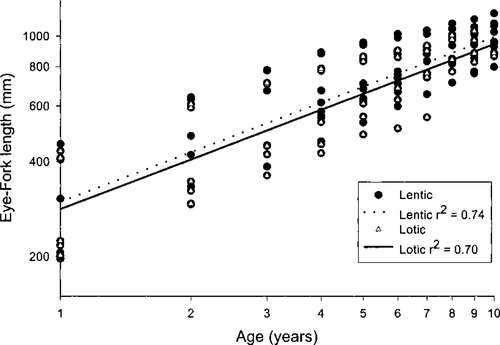
Mean lengths at age and regression lines for 11 lentic and 5 lotic paddlefish populations on a log10-log10 scale
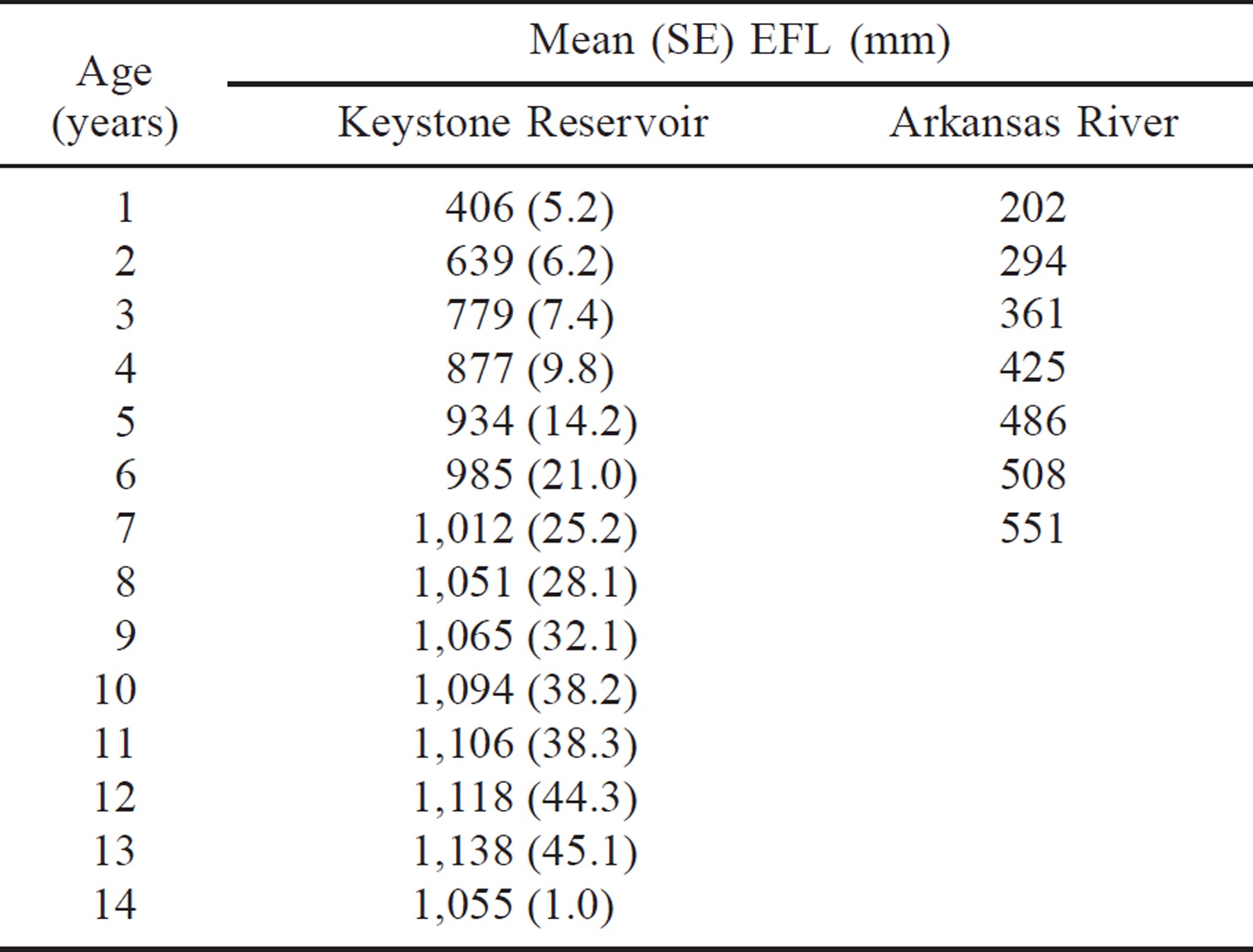
Maximum age varied between river and reservoir populations (Table 1). In addition, the oldest reported paddlefish was from a northern reservoir (age 55; Scarnecchia et al. 1996). Maximum age of paddlefish did not differ between habitat types (P = 0.28) but did differ by geographic region (P = 0.01). Median age for paddlefish populations in the northern United States was 27 years, whereas southern population median was age 11.
Discussion
Keystone Reservoir Population Characteristics
Length frequency and age structure data suggested that Keystone Reservoir has a self-sustaining paddlefish population. Our paddlefish population estimates (6,540–10,251; Paukert 1998) and corresponding density estimates (0.62–0.97 fish/ha) were similar to other large lentic environments in the southern United States (e.g., Grand Lake, Oklahoma, 0.69–2.99 fish/ha [Ambler 1994] and Lake Cumberland, Kentucky, 0.64 fish/ha [Hageman et al. 1988]) but were considerably lower than an unfished subimpoundment of Lake Barkley, Tennessee (8.80 fish/ha; Boone and Timmons 1995).
Paddlefish spatial distribution within reservoir systems is poorly documented (Russell 1986). Van Eckout (1980) found concentrations of paddlefish in a large wind-swept embayment of Lake Sakakawea, North Dakota, during summer, and Hageman et al. (1988) observed a fall upstream migration in Lake Cumberland, Kentucky. In Keystone Reservoir, catch rates of paddlefish differed among areas and years. High catch rates in the Cimarron River arm in 1996, particularly in the upper reaches, indicated that paddlefish were staging in this tributary arm waiting for spring flows before migrating upriver to spawn. However, reduced flows prohibited paddlefish spawning migrations that year, thus concentrating paddlefish in this area (Paukert and Fisher 2001). Paddlefish distribution during the winters of 1997 and 1998 may be more typical (i.e., higher catch rates in the lower Cimarron River arm, Salt Creek arm, and the Arkansas River arm). In these 2 years, substantial water flows dictated paddlefish staging and subsequent migration upriver to their spawning locations (Paukert and Fisher 2001). The morphometry of the lower Cimarron River and Arkansas River arms are very similar, each with a wide, poorly-defined channel and deep water (>10 m). High catch rates of paddlefish in the Salt Creek arm were probably a result of increased sampling efficiency due to its well defined channel and multiple constriction points. Paddlefish typically stage in the upper ends of the reservoir when water temperatures rise to 10°C, and they move upriver when flows increase (Russell 1986). This appears to have occurred in the Cimarron River arm in 1996, when paddlefish were already staging by mid-February. In 1997 and 1998, our sampling began earlier (November), and paddlefish started moving upriver from mid-February to mid-March.
In general, catch rates were highest at intermediate distances from the dam. Sampling efficiency may have been low in the lower, wider reservoir areas; however, low catch rates in the upper river arms indicate few paddlefish use these shallow regions. Telemetry tracking also indicated high paddlefish use of the lower and middle Arkansas River arm in summer, but fish were rarely encountered upstream of river kilometer 18 (Paukert and Fisher 2000). Although the main pool of Keystone Reservoir had lower catch rates throughout the 3-year study (probably because of low sampling efficiency in this wide, deep area), telemetry tracking revealed substantial use of this area during summer (Paukert and Fisher 2000).
Winter site fidelity of paddlefish in Keystone Reservoir varied among years. Recaptures during our winter sampling indicated that fish tagged in the Cimarron River arm in 1996 moved to other areas of the reservoir in winter 1997 and 1998. Paddlefish tagged in 1997 showed no fidelity to any area of the reservoir after being at large for 1 year. Recaptures of fish tagged during the same sampling season showed variable movement throughout the reservoir; however, most fish remained in the same area in which they were tagged. These data suggest that paddlefish make annual within-reservoir movements but remain in the same general areas during winter. Paukert and Fisher (2000) also determined paddlefish in Keystone Reservoir remain in the same general area during summer.
Environmental conditions may influence paddlefish catch during winter. For all areas and years combined, CPUE increased with higher surface water temperature and lower bottom conductivity. Conversely, Gengerke (1978) found that decreased temperature led to higher paddlefish CPUE in the Mississippi River. In Alabama, Lein and DeVries (1998) determined water temperature and CPUE in rivers were positively related during spring before spawning; they also found that water temperature, discharge, and photoperiod were negatively related to Alabama River CPUE after spawning occurred. During summer, paddlefish may avoid the Cimarron River arm because of the higher conductivities (Paukert and Fisher 2000). From a laboratory study, Neill et al. (1994) suggested juvenile paddlefish avoid high salinities. However, paddlefish were found in the upper Cimarron River arm in late winter 1996, where they were staging to move upriver to spawn. Environmental variables (water flow, photoperiod, water temperature) certainly dictate spring distribution and movement (Purkett 1961; Lein and DeVries 1998; Paukert 1998); however, other variables (e.g., conductivity) may influence distribution and movement during other seasons. Clearly, further research should focus on the influence of physicochemical variables on paddlefish distribution and movement in lentic environments.
Body condition of paddlefish in Keystone Reservoir was high. We expected body condition to be lower than populations in similar (southern reservoir) environments because Keystone Reservoir is on the southwestern edge of the paddlefish's range and has harsh environmental conditions (e.g., water temperature reaches 34°C during summer). However, condition was higher than for populations in Louisiana (Reed 1989) and the Alabama River (Hoxmeier and DeVries 1997).
Paddlefish growth in Keystone Reservoir, similar to that of other large southern reservoir populations (e.g., Grand Lake, Oklahoma, [Combs 1982] and Lake Pontchartrain, Louisiana [Reed et al. 1992]), was rapid during the first 4 years of life and slower thereafter. Keystone Reservoir paddlefish exhibited fast growth and a short life span of up to 14 years. Rapid growth is common in lentic waters, particularly in those with water-level fluctuations that increase plankton abundance during high-water periods (Houser and Bross 1959). Paddlefish growth in Keystone Reservoir was greater than it was in the preimpounded Arkansas and Cimarron rivers, for which the maximum reported length was 511 mm (age 7; Linton 1961). In contrast, paddlefish in Keystone Reservoir reached 639 mm at age 2 (Table 2). Although age-55 paddlefish have been reported in a northern reservoir (Scarnecchia et al. 1996), maximum age of paddlefish in southern waters (Combs 1982; Reed et al. 1992; Lein and DeVries 1998) is comparable to the ages we found in the Keystone Reservoir population.
Exploitation from sport fishing was minimal in the Keystone Reservoir system. Throughout our 3-year study, exploitation ranged from 0.5% to 1.2%, which is well below the suggested maximum allowable (i.e., to maintain a natural paddlefish population) exploitation rate of 15% (Combs 1982). Although nonreporting of tags is a problem when estimating exploitation (Gengerke 1978; Rosen et al. 1982), exploitation of the Keystone Reservoir population would still be minimal, even if nonreporting was high (e.g., 50%).
Our annual mortality estimates of 27–34% were intermediate between those for populations in northern and southern U. S. waters. Because exploitation is low in the Keystone Reservoir system, we believe our total annual mortality rates primarily reflect natural mortality. In Louisiana, Reed et al. (1992) reported total annual mortality (considered mainly as natural mortality) to be 26–48%, whereas Hoxmeier and DeVries (1997) found annual mortality estimates of 34–36% in the Alabama River. Total annual mortality ranged from 9% in an unfished subimpoundment in Tennessee (Boone and Timmons 1995) to 69% in a commercially fished southern reservoir (Hoffnagle and Timmons 1989)
Lentic and Lotic Population Characteristics
Lotic paddlefish populations presumably exhibit different population characteristics (e.g., growth and maximum age) than lentic populations (Reed et al. 1992). Lein and DeVries (1998) suggested that habitat differences between reservoirs and rivers influenced the structure and growth of paddlefish populations in Alabama. Hubert et al. (1984) concluded that fish from lake (reservoir) populations grow faster than those from riverine populations. Reservoir paddlefish populations exhibited more rapid initial growth than riverine populations. However, subsequent growth rates were similar for fish from both habitat types. Houser and Bross (1959) noted very fast (721 mm at age 1) initial growth of paddlefish in a new Oklahoma reservoir due to the high influx of primary production. Vondracek et al. (1982) also found faster growth in reservoir populations of Tahoe suckers Catostomus tahoensis compared with populations in tributary rivers. Although mean length at age was higher for paddlefish in lentic than lotic populations, the difference was attributed to higher first-year growth. Subsequent growth rates were not different, suggesting that first-year growth is important in the overall paddlefish growth.
Maximum attainable length did not differ between habitat types or among geographic areas. Regardless of locations or habitat, paddlefish populations have the potential to attain the same maximum lengths. Maximum ages did not differ between reservoir and riverine paddlefish populations but were higher in northern waters compared with southern waters. Lein and DeVries (1998) suggested that differences in latitude (infertile systems with shorter growing season in the north) may result in differences in paddlefish population structure and growth.
Mortality rates tend to be lower in lotic than lentic environments. However, most annual mortality estimates came from catch curves, and fishing mortality could not be accurately computed (Gengerke 1978; Paukert 1998). For lentic populations, total annual mortality estimates ranged from 26% (Lake Pontchartrain, Louisiana; Reed et al. 1992) to 69% (Kentucky Lake, Kentucky; Hoffnagle and Timmons 1989). Lotic population total annual mortality ranged from 18% (Missouri River, South Dakota; Rosen et al. 1982) to 43% (Atchafalya River, Louisiana; Reed et al. 1992). These data were variable, and variations in recruitment (e.g., one strong year-class) and exploitation may influence these estimates. More research on factors affecting mortality is needed to further reveal the difference between lotic and lentic populations.
In summary, creation of impoundments may diminish recruitment of paddlefish by destroying spawning grounds (Carlson and Bonislawsky 1981). In some instances, paddlefish populations have been extirpated by impoundments, and restoration efforts are underway (e. g., in Oklahoma and Kansas, Bob Pitman, U.S. Fish and Wildlife Service, personal communication). However, paddlefish can thrive in impounded rivers, given adequate riverine spawning substrate. Paddlefish occurred in the Arkansas and Cimarron rivers before the impoundment of Keystone Reservoir (Linton 1961), and anecdotal reports, along with our data, suggest the population is self-sustaining and may be increasing. Although Keystone Reservoir is on the southwestern edge of the paddlefish's range and exhibits harsh environmental conditions (poor spawning substrate, regulated flows, high water temperatures), paddlefish have adapted and currently exhibit rapid growth, high condition, and relatively stable recruitment. Paddlefish exhibit differences in growth between lotic and lentic environments. Initial growth in lentic environments was higher than in lotic systems. However, growth rates were similar at older ages. Other population characteristics (e.g., condition, maximum age, mortality) may also differ, but confounding factors (e.g., seasonal and geographic differences) make it difficult to differentiate these factors. In addition to lentic and lotic differences, latitudinal differences also play a role in paddlefish population characteristics.
Acknowledgments
We would like to thank the G. Lein, J. Hoxmeier, K. Graham, J. Pitlo, D. Scanecchia, and B. Reed for input on paddlefish populations they sampled. C. McCoy, B. Brown, G. Thomas, R. Hyler, P. Balkenbush, J. Long, R. Attebury, M. Cole, and J. Whittier helped with field collections. Funding for this project was provided by the Federal Aid in Sport Fish Restoration Act under Project F-41-R of the Oklahoma Department of Wildlife Conservation. The Oklahoma Cooperative Fish and Wildlife Research Unit is a cooperative program of the U.S. Geological Survey, Biological Resources Division; the Oklahoma Department of Wildlife Conservation; Oklahoma State University; and the Wildlife Management Institute.




